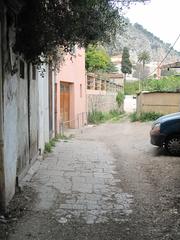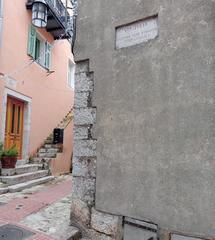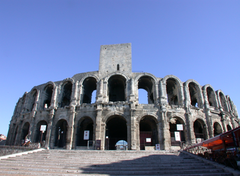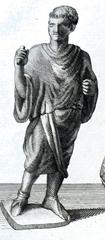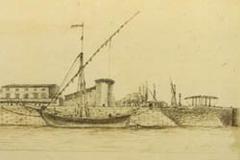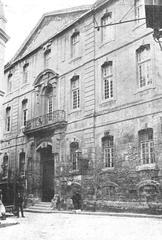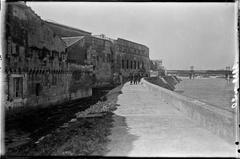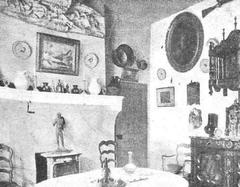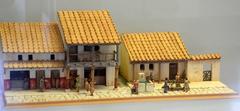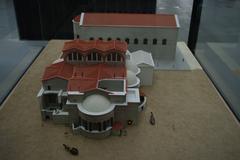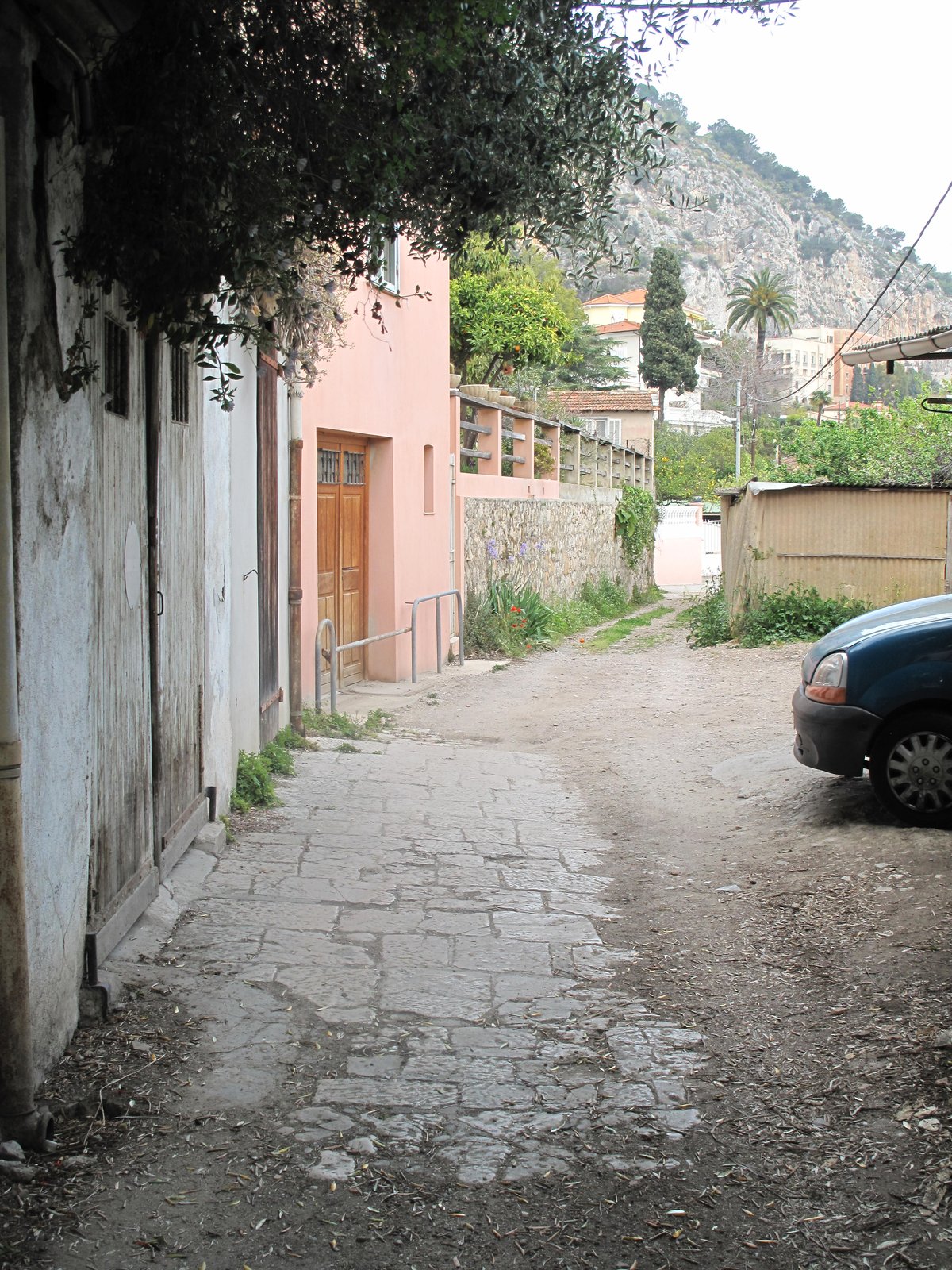
Via Julia Augusta Visiting Hours, Tickets, and Historical Sites in Arles, France
Date: 14/06/2025
Introduction
The Via Julia Augusta stands as a testament to Roman engineering and the enduring influence of the Roman Empire in southern France. Commissioned in 13 BCE by Emperor Augustus, this ancient road connected Italy to Arles and beyond, facilitating military, commercial, and cultural exchanges throughout the Mediterranean. Today, the Via Julia Augusta offers travelers the chance to explore a landscape rich in archaeological wonders, from towering monuments to atmospheric ruins nestled in vibrant towns. Arles, a pivotal city on this route, is especially celebrated for its wealth of Roman heritage, including the iconic Flavian Amphitheater and Ancient Theater, making it a focal point for visitors seeking to experience the grandeur of Roman Gaul (romeonrome.com; arles-guide.com; fr.wikipedia.org).
This comprehensive guide provides detailed information on visiting hours, ticketing, site accessibility, travel tips, and the cultural significance of the Via Julia Augusta in Arles. Whether you are a history enthusiast, cultural traveler, or simply curious about the region’s Roman past, this resource will help you plan an enriching and memorable visit (Arles Tourisme; Smithsonian Magazine).
Table of Contents
- Introduction
- What is the Via Julia Augusta?
- Historical Significance of the Via Julia Augusta in Arles
- Key Arles Historical Sites Along the Via Julia Augusta
- Visiting Hours and Tickets
- How to Access the Via Julia Augusta
- Guided Tours and Travel Tips
- Accessibility Information
- Architectural and Cultural Highlights
- Nearby Attractions
- Practical Visitor Tips
- Visitor Facilities and Services
- Preservation Efforts and Community Engagement
- Influence on Regional Tourism and Education
- Artistic and Literary Resonance
- Contemporary Significance in European Heritage
- Integration with Modern Infrastructure and Daily Life
- Visitor Engagement and Experiential Opportunities
- Safety, Etiquette, and Practical Tips
- Frequently Asked Questions (FAQ)
- Conclusion
What is the Via Julia Augusta?
The Via Julia Augusta was a vital Roman road commissioned by Emperor Augustus in 13 BCE, linking Piacenza in Italy to Arles in France. The route was essential for the movement of troops, goods, and culture across the Roman Empire. Today, the Via Julia Augusta survives in well-preserved sections along the Ligurian and Provençal coasts, inviting modern visitors to walk in the footsteps of emperors and merchants and to experience the region’s Roman past firsthand (romeonrome.com; en.wikipedia.org).
Historical Significance of the Via Julia Augusta in Arles
Arles was a major Roman metropolis, situated at the crossroads of the Via Julia Augusta and Via Domitia. Its allegiance to Julius Caesar during the Roman Civil War led to its elevation as Colonia Julia Paterna Arelatensium Sextanorum, a settlement for veterans of the 6th Legion. The construction of the Via Julia Augusta solidified Arles’ role as a key hub for trade, military operations, and cultural exchange. Marked by milestones and regularly restored by later emperors, the road embodies the city’s integration into the Roman world (fr.wikipedia.org; romeonrome.com).
Key Arles Historical Sites Along the Via Julia Augusta
The Flavian Amphitheater (Arènes d’Arles)
- Description: Built around 90 AD, this amphitheater could host 21,000 spectators. It was used for gladiatorial contests and public spectacles and remains a UNESCO World Heritage Site (thecrazytourist.com).
- Visiting Hours: 9:30 AM–6:30 PM (April–September); 9:30 AM–5 PM (October–March).
- Tickets: €10 for adults; discounts for EU residents and under-26s. Combination tickets available.
- Accessibility: Ramps and support for visitors with mobility needs.
The Ancient Theater
- Description: Dating to the 1st century BC, seating about 10,000 people and originally adorned with statues of Augustus (thecrazytourist.com).
- Visiting Hours: 9:30 AM–6 PM (April–September); 9:30 AM–5 PM (October–March).
- Tickets: Included in combination pass with the amphitheater.
- Accessibility: Some uneven surfaces; assistance available.
The Cryptoporticus
- Description: Underground vaulted galleries beneath the Place du Forum, built in the 1st century BC to support the forum (arles-guide.com).
- Visiting Hours: 10 AM–5 PM; closed Tuesdays.
- Tickets: Included in combination ticket.
- Accessibility: Limited due to stairs.
The Alyscamps Necropolis
- Description: One of the most notable Roman burial grounds, lining the Via Julia Augusta outside Arles (arles-guide.com).
- Visiting Hours: Open daily; free access.
Roman Walls and Gates
- Description: Surviving fragments mark the city’s ancient limits (arles-guide.com).
- Visiting: Free access with onsite information panels.
The Baths of Constantine
- Description: Early 4th-century public baths reflecting Roman social life (arles-guide.com).
- Visiting Hours: 9:30 AM–6 PM (April–September); 9:30 AM–5 PM (October–March).
- Tickets: Included in combination passes.
- Accessibility: Mostly accessible; some uneven ground.
Musée Départemental de l’Arles Antique
- Description: Museum displaying artifacts from 2500 BC to the 6th century AD, including a notable bust of Julius Caesar (romeonrome.com).
- Visiting Hours: Tuesday–Sunday, 10 AM–6 PM; closed Mondays.
- Tickets: €9 for adults; discounts available.
- Accessibility: Fully accessible.
Visiting Hours and Tickets
- Most Roman sites in Arles: Open daily, typically 9:00/9:30 AM to 6:00/7:00 PM in spring and summer; shorter hours in winter.
- Combination Pass: €19 for access to six major monuments.
- Single Entry: €7–€9 per adult.
- Advance Booking: Usually not required; tickets sold on-site (The Empty Nest Explorers).
How to Access the Via Julia Augusta
- By Road: Arles is accessible via the A54/E80 motorway (Exit 5 Arles Centre). From Avignon, take the N570 (Arles Tourism).
- By Train: The Arles station is close to the historic center, with TGV connections from Avignon and Nîmes.
- By Air: Marseille Provence and Montpellier airports are about 78 km away, with shuttle and train links.
- Parking: Use Parking des Lices or Parc du Centre, as historic center parking is limited.
Guided Tours and Travel Tips
- Guided Tours: Certified guides offer thematic walks and group tours. Book through the tourism office (Arles Tourism).
- Travel Tips: Wear sturdy shoes, bring water and sun protection, and check weather and opening hours before visiting.
Accessibility Information
- Mobility: Many monuments have ramps and accessible paths, though some ancient streets and underground sites may be challenging.
- Visitor Centers: Offer help and information on accessible routes.
Architectural and Cultural Highlights
- Monumental Funerary Tombs: Along the road, especially between Albenga and Alassio.
- Early Christian Sites: Such as the San Calocero complex, reflecting the spread of Christianity.
- Tropaeum Alpium: A monumental limestone tower near La Turbie, commemorating Augustus’ Alpine victory.
Nearby Attractions
- Monaco: Just south of La Turbie, famed for its harbor.
- Ligurian Towns: Albenga, Alassio, and Ventimiglia, known for their history and cuisine.
- Provence’s Vineyards and Parks: Combine the Via Julia Augusta visit with broader explorations.
Practical Visitor Tips
- Maps and Itineraries: Available at the tourist office; QR codes provide digital guides (The Empty Nest Explorers).
- Festivals: Attend the Arelate Roman Days in late August for reenactments and workshops (france-voyage.com).
- Market Days: Wednesdays and Saturdays enliven the center and may affect access.
Visitor Facilities and Services
- Tourist Information: Main office at 9 Boulevard des Lices. Open weekdays, offering maps, brochures, and assistance (Arles Tourism).
- Accommodation: Over 1,600 hotel rooms from budget to luxury.
- Restrooms and Amenities: Available at key sites and in the center.
Preservation Efforts and Community Engagement
The city, local historians, and organizations actively maintain and promote the Via Julia Augusta. Initiatives include archaeological surveys, restoration, festivals, and digital resources like interactive maps (Smithsonian Magazine).
Influence on Regional Tourism and Education
The Via Julia Augusta is central to Arles’ tourism strategy. Guided walks, interpretive panels, and educational initiatives connect visitors to Roman engineering and regional identity (Arles Tourisme).
Artistic and Literary Resonance
The road has inspired writers, artists, and photographers, shaping Provence’s romantic image and fostering cultural pride (Smithsonian Magazine).
Contemporary Significance in European Heritage
As part of a broader network, the Via Julia Augusta symbolizes cross-border ties and shared European identity, and is featured in heritage tourism and research (Salt in Our Hair).
Integration with Modern Infrastructure
Parts of the Via Julia Augusta still influence modern roadways and property lines. Local businesses frequently reference its heritage.
Visitor Engagement and Experiential Opportunities
Walking or cycling the route, participating in reenactments, and using audio guides offer immersive experiences (Arles Tourisme).
Safety, Etiquette, and Practical Tips
- Safety: Arles is generally safe; guard valuables in crowded areas.
- Dress: Wear comfortable shoes; dress modestly at religious sites.
- Photography: Permitted at most sites, with some restrictions during events.
Frequently Asked Questions (FAQ)
Q: Do I need to book tickets in advance?
A: Not usually; tickets are available on-site.
Q: What are the opening hours for the Flavian Amphitheater?
A: Typically 9:00/9:30 AM–6:00/7:00 PM in peak months; shorter hours in winter.
Q: Is Arles accessible for those with limited mobility?
A: Many monuments are accessible; some ancient streets and underground sites may be challenging.
Q: What’s the best time to visit?
A: Spring and autumn offer pleasant weather and fewer crowds; July and August feature major festivals.
Q: Are guided tours available?
A: Yes, through the tourism office and local operators.
Conclusion and Call to Action
The Via Julia Augusta is more than an ancient road—it is a living legacy connecting past and present in Arles and across Provence. The city’s Roman monuments, accessible facilities, engaging tours, and vibrant cultural programming make it a must-visit destination for history lovers and curious travelers alike. For the latest visiting hours, ticket details, and festival updates, consult the official Arles tourism website or download the Audiala app for interactive guides and maps.
References
- romeonrome.com
- arles-guide.com
- Arles Tourisme
- The Empty Nest Explorers
- Smithsonian Magazine
- en.wikipedia.org
- menton-riviera-merveilles.co.uk
- Rencontres d’Arles
- fr.wikipedia.org
- thecrazytourist.com
